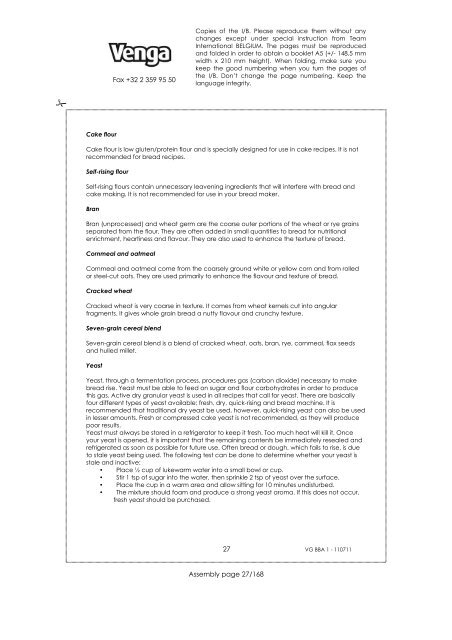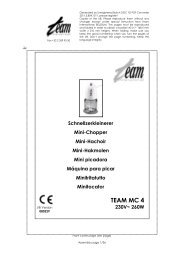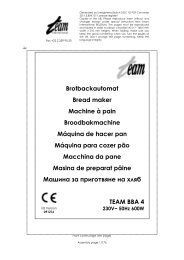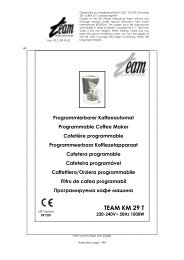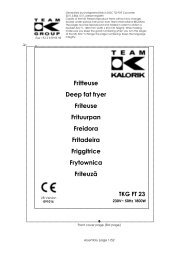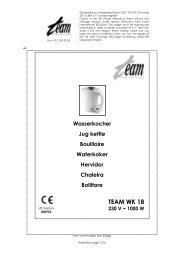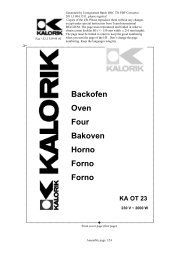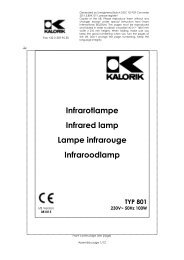VG BBA 1
VG BBA 1
VG BBA 1
You also want an ePaper? Increase the reach of your titles
YUMPU automatically turns print PDFs into web optimized ePapers that Google loves.
�<br />
Cake flour<br />
Fax +32 2 359 95 50<br />
Copies of the I/B. Please reproduce them without any<br />
changes except under special instruction from Team<br />
International BELGIUM. The pages must be reproduced<br />
and folded in order to obtain a booklet A5 (+/- 148.5 mm<br />
width x 210 mm height). When folding, make sure you<br />
keep the good numbering when you turn the pages of<br />
the I/B. Don’t change the page numbering. Keep the<br />
language integrity.<br />
Cake flour is low gluten/protein flour and is specially designed for use in cake recipes. It is not<br />
recommended for bread recipes.<br />
Self-rising flour<br />
Self-rising flours contain unnecessary leavening ingredients that will interfere with bread and<br />
cake making. It is not recommended for use in your bread maker.<br />
Bran<br />
Bran (unprocessed) and wheat germ are the coarse outer portions of the wheat or rye grains<br />
separated from the flour. They are often added in small quantities to bread for nutritional<br />
enrichment, heartiness and flavour. They are also used to enhance the texture of bread.<br />
Cornmeal and oatmeal<br />
Cornmeal and oatmeal come from the coarsely ground white or yellow corn and from rolled<br />
or steel-cut oats. They are used primarily to enhance the flavour and texture of bread.<br />
Cracked wheat<br />
Cracked wheat is very coarse in texture. It comes from wheat kernels cut into angular<br />
fragments. It gives whole grain bread a nutty flavour and crunchy texture.<br />
Seven-grain cereal blend<br />
Seven-grain cereal blend is a blend of cracked wheat, oats, bran, rye, cornmeal, flax seeds<br />
and hulled millet.<br />
Yeast<br />
Yeast, through a fermentation process, procedures gas (carbon dioxide) necessary to make<br />
bread rise. Yeast must be able to feed on sugar and flour carbohydrates in order to produce<br />
this gas. Active dry granular yeast is used in all recipes that call for yeast. There are basically<br />
four different types of yeast available; fresh, dry, quick-rising and bread machine. It is<br />
recommended that traditional dry yeast be used, however, quick-rising yeast can also be used<br />
in lesser amounts. Fresh or compressed cake yeast is not recommended, as they will produce<br />
poor results.<br />
Yeast must always be stored in a refrigerator to keep it fresh. Too much heat will kill it. Once<br />
your yeast is opened, it is important that the remaining contents be immediately resealed and<br />
refrigerated as soon as possible for future use. Often bread or dough, which fails to rise, is due<br />
to stale yeast being used. The following test can be done to determine whether your yeast is<br />
stale and inactive:<br />
� Place ½ cup of lukewarm water into a small bowl or cup.<br />
� Stir 1 tsp of sugar into the water, then sprinkle 2 tsp of yeast over the surface.<br />
� Place the cup in a warm area and allow sitting for 10 minutes undisturbed.<br />
� The mixture should foam and produce a strong yeast aroma. If this does not occur,<br />
fresh yeast should be purchased.<br />
27 <strong>VG</strong> <strong>BBA</strong> 1 - 110711<br />
Assembly page 27/168


